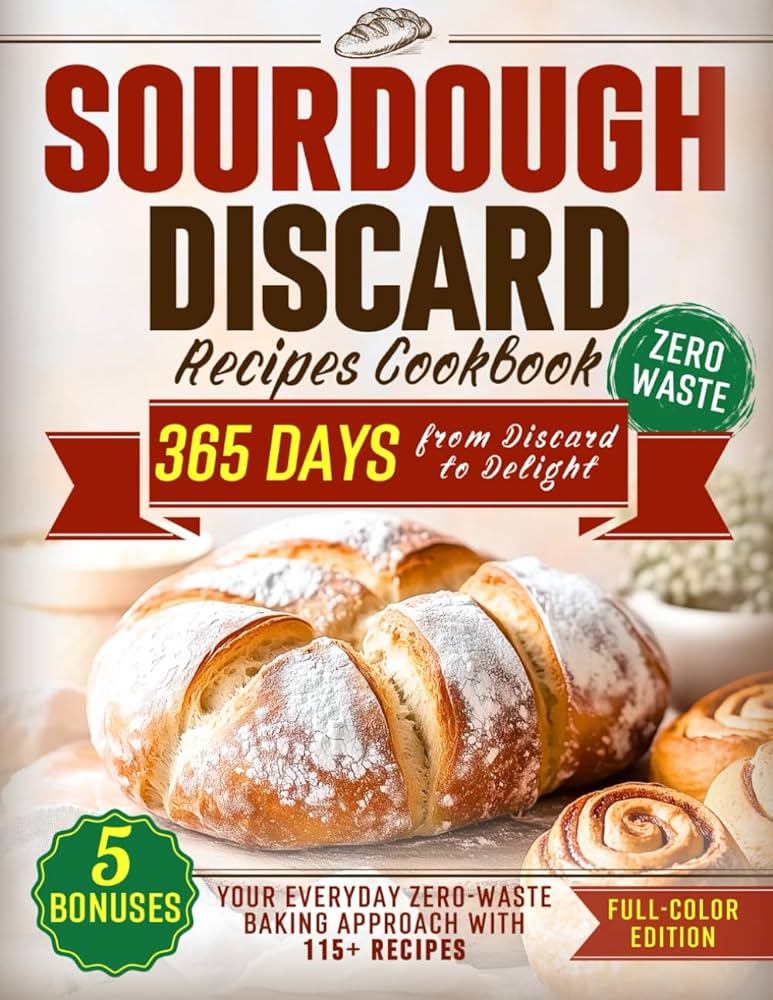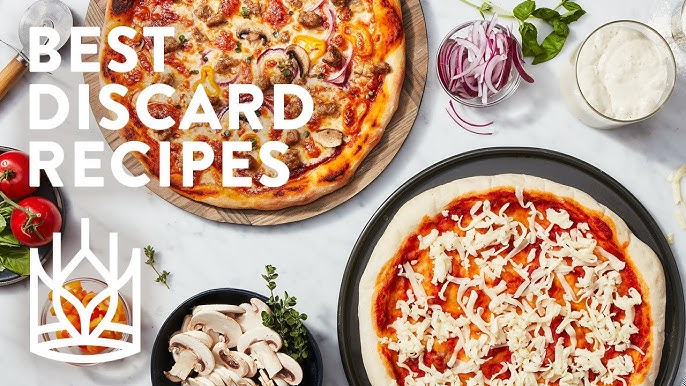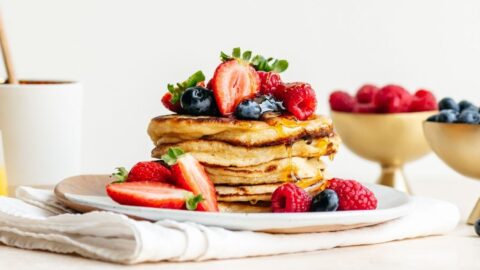Home baking has a way of turning the ordinary into the extraordinary, and nothing embodies that spirit quite like sourdough. That crusty, tangy loaf you’ve mastered? It’s the culmination of patience, flour, and a lively starter. But what about the discard—the portion you scoop out during feedings to keep your starter in check? Far from waste, sourdough discard is a flavor powerhouse waiting to elevate your kitchen experiments. At TasteTrove, we’re dedicated to making baking accessible and delicious for every home cook, and this guide is your roadmap to flavorful sourdough discard recipes that pack punch without the fuss.
Whether you’re a weekend warrior whipping up breakfast stacks or a midweek meal prepper craving savory snacks, discard adds that signature fermented tang—think subtle sour notes that deepen everything from cookies to cornbread. No more guilt over tossing it down the drain; instead, channel it into zero-waste wins. We’ll explore what discard really is, why it’s a baker’s best friend, essential tips, and five mouthwatering recipes to get you started. From sweet treats to hearty loaves, these ideas draw inspiration from trusted sources like King Arthur Baking’s discard collection and The Clever Carrot’s creative twists. Ready to rescue that jar from the fridge? Let’s dive in and bake something unforgettable.
Understanding Sourdough Discard: The Unsung Hero of Your Starter
At its core, sourdough discard is the unfed portion of your starter that you remove before adding fresh flour and water. A healthy starter is a balanced ecosystem of wild yeast and lactic acid bacteria, typically maintained at 100% hydration (equal parts flour and water by weight). To prevent overgrowth and excessive acidity, bakers discard about half before each feeding—hence the name. But don’t let “discard” fool you; this isn’t spoiled goods. It’s mature starter brimming with flavor, just not at peak activity for bread rising.
Fresh discard smells pleasantly tangy, like yogurt or beer, and it’s most potent within a few days at room temperature or a week in the fridge. Freeze it in portions for up to three months, and it’ll thaw ready for action. Historically, resourceful bakers from ancient civilizations to frontier homesteads repurposed discard into flatbreads and porridges, a practice echoed in modern zero-waste cooking. If you’re new to starters, our beginner’s guide to sourdough starters covers everything from creation to care.
The beauty of discard lies in its versatility. Unlike active starter, which shines in long-ferment loaves, discard thrives in quick-bake recipes where chemical leaveners like baking soda take the lead. Its acidity reacts beautifully with bases for lift and tenderness, while the fermentation softens gluten for easier digestion. As noted in resources like https://tastetrove.net/ it’s a sustainable swap that cuts kitchen waste and amps up taste.

Why Home Bakers Love Sourdough Discard: Flavor, Nutrition, and Sustainability
Embracing discard isn’t just practical—it’s transformative. That mild sourness infuses depth into baked goods, mimicking buttermilk or kefir without extra ingredients. Imagine chocolate chip cookies with a whisper of tang cutting through the sweetness, or crackers that snap with savory edge. Nutritionally, fermentation in discard reduces phytic acid, boosting mineral absorption like iron and zinc, according to insights from baking science hubs.
For home bakers, it’s a sustainability flex: The average sourdough enthusiast discards enough starter annually to bake a dozen extra loaves if repurposed. It aligns perfectly with TasteTrove’s ethos of mindful meals, turning potential trash into treasure. Plus, it’s forgiving—perfect for busy schedules since most recipes skip long rises. One downside? Overly mature discard can overpower delicate flavors, so taste-test and balance with sweeteners or salts as needed. Dive deeper into the perks with Farmhouse on Boone’s discard archives, where simple swaps yield big rewards
Flavorful Sourdough is a delightful bread that captivates with its tangy, complex taste. The secret to Flavorful Sourdough lies in its natural fermentation, which develops a unique depth of flavor. Crafting Flavorful Sourdough requires patience, as the wild yeast and bacteria work slowly to create its signature crust and chewy texture. Each loaf of Flavorful Sourdough tells a story of time and care, with a golden exterior and airy crumb. Whether enjoyed with butter or as a sandwich base, Flavorful Sourdough elevates any meal with its artisanal charm.
Pro Tips for Mastering Sourdough Discard in Your Kitchen
Success with discard starts with basics: Weigh it for accuracy (1 cup ≈ 240g), and bring fridge-stored portions to room temp for even mixing. In batters, its acidity pairs with baking soda for fluff—think volcanic bubbles for rise. For doughs, hydrate gradually to avoid stickiness. Storage savvy: Spoon into silicone trays for pop-out portions, or zip-lock flat for stackable freezer space.
Troubleshoot like a pro: If flavors skew too sour, add a dash of vanilla or honey. Always use discard from a healthy starter—off smells mean compost, not cook. Our baking measurement essentials guide ensures precision every time. With these hacks, you’ll wield discard like a seasoned artisan.
Recipe 1: Tangy Sourdough Discard Pancakes – Breakfast Bliss
Kick off your day with these fluffy, flavorful pancakes that rival any brunch spot. The discard’s tang tenderizes the batter for melt-in-your-mouth results. Prep time: 10 minutes. Cook time: 15 minutes. Yields: 8 pancakes.
Ingredients
- 1 cup (240g) sourdough discard
- 1 cup (120g) all-purpose flour
- 1 tbsp sugar
- 1 tsp baking soda
- ½ tsp salt
- 1 egg
- ¾ cup (180ml) milk
- 2 tbsp melted butter
- Optional: Berries for folding in
Instructions
- Whisk dry ingredients (flour, sugar, soda, salt) in a bowl.
- In another, combine discard, egg, milk, and butter until smooth.
- Gently fold wet into dry—lumps are okay for tenderness. Rest 5 minutes.
- Heat a griddle over medium; grease lightly. Dollop ¼ cup batter; cook until bubbly (2-3 minutes), flip, and golden (1 minute).
- Stack and drizzle with syrup. Pro tip: Overnight batter deepens flavor.
These pancakes, inspired by Little Spoon Farm’s easy versions, store well in the fridge for quick reheats. Per serving: 200 calories, 6g protein. Pair with our berry compote recipe for a fruity twist.
Recipe 2: Cheesy Sourdough Discard Crackers – Savory Snacking
Crispy, addictive crackers with a fermented zing—ideal for cheese boards or solo munching. The discard ensures a crisp snap and subtle depth. Prep: 15 minutes. Bake: 20 minutes. Yields: 40 crackers.
Ingredients
- 1 cup (240g) sourdough discard
- ½ cup (60g) flour (whole wheat for nuttiness)
- ¼ cup (55g) softened butter
- ½ cup (50g) grated cheddar
- ½ tsp salt
- Optional: Herbs or seeds for topping
Instructions
- Mix discard and butter until creamy; stir in cheese, salt, and flour to form dough.
- Chill 30 minutes for easy rolling.
- Preheat oven to 350°F (175°C). Roll thin on parchment; cut into squares, prick with fork.
- Sprinkle toppings; bake 15-20 minutes until edges brown. Cool to crisp.
- Store airtight for a week.
Drawing from Amy Bakes Bread’s savory favorites, these are endlessly customizable—add garlic for kick. Per 10 crackers: 150 calories. Dip into our homemade herb dip.
Recipe 3: Sourdough Discard Banana Bread – Moist and Moreish
This loaf transforms ripe bananas and discard into a tender, flavorful classic with a tangy undercurrent. Perfect for tea time. Prep: 15 minutes. Bake: 50 minutes. Yields: 1 loaf (10 slices).
Ingredients
- 1 cup (240g) sourdough discard
- 3 mashed bananas (1 cup)
- ⅓ cup (75g) oil or butter
- 2 eggs
- 1 tsp vanilla
- 1½ cups (180g) flour
- ½ cup (100g) sugar
- 1 tsp baking soda
- ½ tsp cinnamon
- ¼ tsp salt
- ½ cup nuts (optional)
Instructions
- Preheat oven to 350°F (175°C); grease a 9×5 loaf pan.
- Mix wet: Bananas, discard, oil, eggs, vanilla.
- Combine dry: Flour, sugar, soda, cinnamon, salt; fold in with nuts.
- Pour into pan; bake 45-55 minutes until toothpick clean.
- Cool before slicing.
Echoing Pantry Mama’s sweet discard ideas, it’s freezer-friendly. Per slice: 220 calories. Try variations from our quick bread collection.
Recipe 4: Herbed Sourdough Discard Focaccia – Dinner Star
A dimpled, olive oil-drenched flatbread with herbs and discard’s richness—effortless yet impressive. Prep: 20 minutes. Rise/Bake: 30 minutes. Yields: 1 pan (8 servings).
Ingredients
- 1 cup (240g) sourdough discard
- 2 cups (240g) flour
- 1 tsp salt
- 1 tsp sugar
- 2 tsp instant yeast
- ¾ cup (180ml) warm water
- ¼ cup olive oil, plus more
- Fresh rosemary, sea salt for topping
Instructions
- Mix discard, water, sugar, oil; add flour, salt, yeast. Knead into sticky dough.
- Cover; rise 1 hour until doubled.
- Preheat oven to 425°F (220°C). Spread in oiled 9×13 pan; dimple, drizzle oil, sprinkle toppings.
- Bake 20-25 minutes golden.
- Slice warm.
Influenced by Lynn’s Way of Life’s no-knead breads, it’s a sidekick for soups. Per serving: 180 calories. Explore Wild Thistle Kitchen’s sandwich loaves for inspo.
Final Bites: Bake On with Discard Confidence
Sourdough discard isn’t just rescue—it’s revelation, infusing home baking with flavor and flair. From pancakes to focaccia, these recipes prove its range for busy bakers. Stock up on ideas from Farmhouse on Boone’s 35+ options, and tag your creations #TasteTroveDiscard. Head to our sourdough hub for more. Your kitchen awaits—happy baking!
Flavorful Sourdough captures the heart of artisanal baking with its rich, tangy essence. The magic of Flavorful Sourdough comes from its slow fermentation, blending wild yeast and tradition. Each bite of Flavorful Sourdough reveals a crisp crust and a soft, airy interior. Crafting Flavorful Sourdough demands skill, patience, and a passion for quality ingredients. This beloved bread, known as Flavorful Sourdough, transforms simple meals into gourmet experiences.
FAQs About Sourdough Discard
What’s the difference between discard and active starter?
Discard is unfed starter with less rising power, ideal for quick recipes. Active starter is freshly fed, bubbly, and used for leavened breads.
How long can I store flavorful sourdough discard?
Up to 2 days at room temp, 7-10 days in the fridge, or 3 months frozen. Discard if it smells like acetone or shows mold.
Can I use discard in place of flour or liquid in recipes?
Yes, since it’s 100% hydration, it acts as equal parts flour and water. Adjust recipe liquids accordingly.
Why does my flavorful sourdough discard taste too sour?
Older discard builds more acidity. Balance with sugar or baking soda, or use fresher discard.
Can I share flavorful sourdough discard with others?
Yes! It’s a great starter for new bakers—just instruct them to feed it. See our starter sharing guide.
Is flavorful sourdough discard safe to eat?
As long as your starter is healthy (no mold, off odors), discard is safe due to its acidic environment.
Can I use flavorful sourdough discard for bread?
It’s less effective for rising but works with added yeast. Try our discard sandwich loaf.
How do I reduce flaovrful sourdough discard waste?
Use it regularly, maintain a smaller starter, or freeze portions. Explore Zero Waste Chef’s tips.

Essential Products for flavorful Sourdough Discard Baking
These tools make discard recipes a breeze. Affiliate links support TasteTrove.
1. Wide-Mouth Mason Jars (16 oz, Set of 6)
Store flavorful sourdough discard or starters airtight. Wide mouths ease scooping. Amazon (~$15).
2. Silicone Ice Cube Trays
Freeze flavorful sourdough discard in portions for grab-and-go baking. Amazon (~$8).
3. Digital Scale
Precision is key. The OXO Good Grips Scale (~$30) is reliable.
4. Parchment Paper
Non-stick for cookies and flatbreads. Walmart (~$4).
5. Waffle Maker
For perfect waffles, try Cuisinart’s classic (~$50).
6. Sourdough Cookbook
“New World Sourdough” by Bryan Ford (Amazon) inspires creativity (~$20).
Troubleshooting Discard Recipes
- Dense waffles? Ensure baking powder is fresh; rest batter 5 minutes.
- Flatbread too tough? Don’t overknead; roll thinner.
- Overly sour cookies? Add more sugar or use fresher discard.
- Muffins not rising? Check oven temp and leavener.
For more, see Sourdough Brandon’s troubleshooting.
Conclusion: Unleash Your Discard Creativity
Sourdough discard transforms baking into a flavorful, waste-free adventure. From cookies to waffles, these recipes prove its magic for home bakers. Share your creations with #TasteTroveDiscard and explore our sourdough recipe hub for more. Your next masterpiece is just a scoop away!
Related FAQs on Flavorful Sourdough Discard Recipes for Home Bakers
Here are some commonly asked questions about using sourdough discard in flavorful recipes, compiled from expert baking resources. These focus on practical tips for home bakers to create tasty, waste-free baked goods like pancakes, cookies, breads, and more.
- What is sourdough discard?
Sourdough discard is the portion of your starter that’s removed before feeding it fresh flour and water. It’s essentially an unfed, overripe starter that’s tangy and acidic, making it ideal for adding flavor to recipes without leavening power on its own. - Why do we discard part of the sourdough starter, and what’s the benefit in recipes?
Discarding helps balance acidity for better bread rise, controls the starter’s growth to avoid excess, and maintains its health. In recipes, discard adds nutrition, tangy flavor, improved digestibility, and moisture, enhancing treats like cookies or muffins without needing extra leavening agents like baking soda. - How should I store sourdough discard to keep it fresh for baking?
Store it in an airtight jar in the fridge for up to a week (or two at most) to slow fermentation. For longer storage, freeze it in a container for a few months and thaw overnight in the fridge. Avoid room temperature beyond 1-2 days, as it becomes overly acidic. If a brown liquid (hooch) forms, stir it in or pour it off—discard only if moldy or foul-smelling. - Can I use sourdough discard straight from the fridge in recipes?
Yes, especially for quick “no-wait” recipes like pancakes, waffles, or crepes. For best results in flavorful bakes, use discard from a healthy starter fed within the last week. It adds a tangy, yogurt-like taste that pairs well with sweet or savory ingredients. - What does sourdough discard add to the flavor and texture of recipes?
It imparts a subtle sour tang, similar to buttermilk or yogurt, which enhances depth in baked goods. In cookies or cakes, it improves tenderness and moisture; in savory items like crackers, it adds a fermented umami. Adjust recipes by reducing liquids and flour since discard is typically 50/50 water and flour. - How can I reduce waste from sourdough discard?
Maintain a smaller starter to produce less discard, create a separate levain for baking, or share excess with friends. Collect discard over time in the fridge and use it in batches for recipes like granola or biscuits to minimize tossing it out. - Are there health benefits to baking with sourdough discard?
It contains probiotics from fermentation, potentially making baked goods easier to digest and supporting gut health. It also helps items stay fresh longer due to its acidity, though it’s not a guaranteed health booster. - Can sourdough discard be used to start a new starter?
Yes, simply feed the discarded portion in a separate container with flour and water as you would a regular starter. It’s a great way to propagate without waste.
For more recipe inspiration, popular flavorful options include sourdough chocolate chip cookies, pumpkin waffles, biscuits, banana bread, pizza crust, and herb pancakes—these use discard to boost taste without complexity.
Related Products for Flavorful Sourdough Discard Recipes
Home bakers often need tools to measure, mix, and bake with precision when working with discard recipes. Below is a curated list of recommended products, including essentials like scales and jars, plus books for recipe ideas. These are drawn from trusted baking sites and can enhance your flavorful creations.

| Product | Description | Why It’s Useful for Discard Recipes |
|---|---|---|
| Digital Kitchen Scale | A precise scale (e.g., models from OXO or Escali) for weighing ingredients and discard. | Ensures accuracy when adjusting recipes for discard’s hydration, leading to consistent flavorful results. |
| Weck or Mason Jars | Airtight glass jars for storing starter and discard (e.g., Weck tulip jars). | Keeps discard fresh in the fridge or freezer, preserving its tangy flavor for recipes like muffins or cookies. |
| Danish Dough Whisk | A sturdy whisk for mixing thick batters (e.g., from Lodge or similar brands). | Makes incorporating discard into doughs for pancakes or biscuits easier without overmixing. |
| Bench Scraper | Metal or plastic scraper for handling dough (e.g., from King Arthur or OXO). | Helps portion and shape discard-enriched doughs for breads or crackers without sticking. |
| Dutch Oven | Enameled cast iron pot (e.g., Lodge or Le Creuset) for baking. | Traps steam for crusty loaves using discard, enhancing flavor in no-knead breads. |
| Proofing Basket (Banneton) | Cane or rattan basket with liner for shaping. | Supports rising dough in discard breads, improving texture and flavor development. |
| Non-Stick Flour-Sack Towels | Lint-free cotton towels dusted with rice flour. | Covers dough during proofing to prevent sticking, useful for flavorful discard English muffins or rolls. |
| Sourdough Starter Kit | Bundles with jars, scrapers, and tools (e.g., from Amazon or Cultures for Health). | All-in-one for beginners to manage discard and experiment with recipes. |
| “Artisan Sourdough Made Simple” Book by Emilie Raffa | A beginner-friendly book with discard recipes and tips. | Provides flavorful recipe ideas like pancakes and guides on using discard creatively. |
These products are widely available on sites like Amazon, King Arthur Baking, or specialty baking stores. Start with basics like a scale and jars if you’re new to incorporating discard for flavorful home bakes.